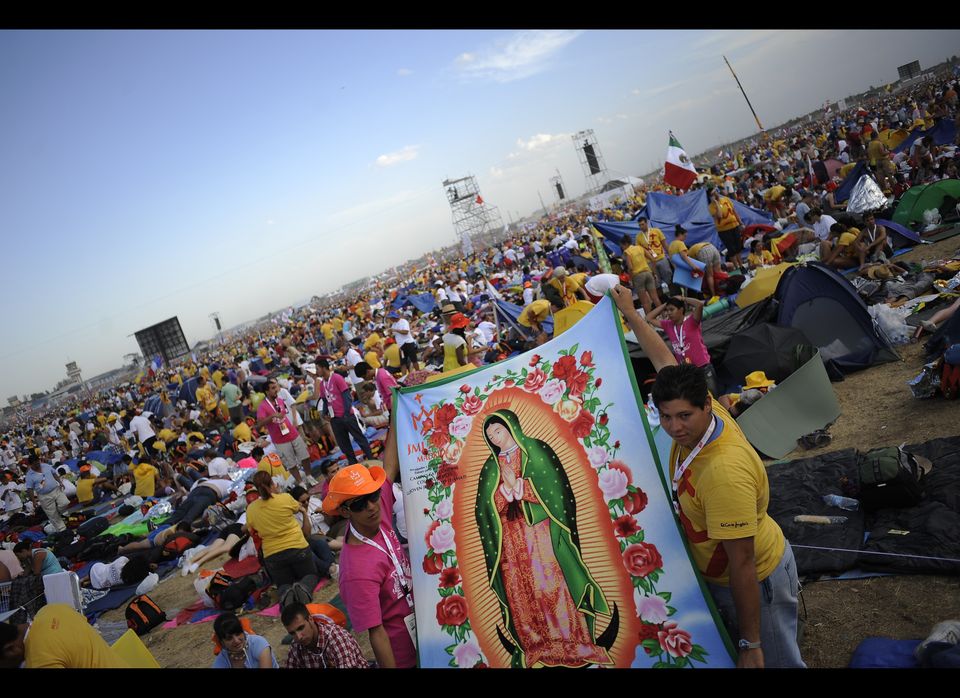From Salt Lake City to Los Angeles, from Antigua, Guatemala, to Manila, Philippines, the image of the dark-skinned patron saint of the Americas is venerated with colorful celebrations.
But the feast of Our Lady of Guadalupe, Mexico's patron, who is honored every Dec.12, has become the largest Catholic pilgrimage in the world with as many as six million worshipers traveling to the Basilica of Guadalupe over the two days of the celebration.
In addition, an annual torch relay from Mexico City to New York honors the Virgin's apparition, a 3,100-mile journey intended to highlight her widespread veneration, according to participants.
Our Lady of Guadalupe is arguably one of the most popular cultural and religious symbols among Latinos in the U.S., her ubiquitous image adorning altars in homes, small business and churches, on murals and public shrines across East Los Angeles. Speaking of her popular appeal, Mexican poet and Nobel Laureate Octavio Paz once said: "The Mexican people, after more than two centuries of experiments and defeats, have faith only in the Virgin of Guadalupe and the National Lottery."
Her image adorned the flag of Miguel Hidalgo's insurgent army in the 1800s and the banners of the United Farm Workers movement in California.
Guadalupe, Coatlaxopeuh, Tonantzin
According to legend, the Virgin appeared before the peasant Juan Diego only ten years after the Spanish conquest. The symbolism of the Virgin of Guadalupe can be interpreted from both indigenous and Spanish perspectives.
Whether or not the Virgin of Guadalupe actually appeared to the indigenous peasant Juan Diego in 1531 at Tepeyac Hill is a question of faith. What is certain is that the cultural significance of her image for Latinos across the Americas is indelible.
According to anthropologists, the duality of her symbolism spoke to both Spanish and indigenous Nahauatl audiences in the sixteenth century. Her very name, Guadalupe is the Spanish pronunciation of the Nahuatl name Coatlaxopeuh, a Mesoamerican fertility goddess.
The well-known image is, according to scholars, full of a number of symbols that strongly relate it with the culture and history of the indigenous people.
To native people, the image would have been read as a pictograph. Jeanette Rodriguez, author of "Our Lady of Guadalupe: Faith and Empowerment Among Mexican-American Women," writes that the icon "is more than simply a picture. For the people who inhabited central and southern Mexico and parts of Central America before the Spanish arrival, the image of Our Lady of Guadalupe contains codices - ancient symbols and words."
In the spirit of mestizaje, the blending of different cultures and faiths, this interactive graphic explores just a few of the origins and meanings of the icon:
Father Paul Sustayta, pastor at St. Andrew Church in Pasadena, will celebrate his 20th Our Lady of Guadalupe mass on Monday. He said he is always amazed at the number of people who arrive in the early morning hours. "I call it the Guadalupe encounter or event because it had such an impact on people then and it still does now," he said. "Juan Diego had an encounter, but all people who have devotion to Guadalupe has that encounter today."
Our Lady of Angels Cathedral in downtown Los Angeles will begin the Virgin of Guadalupe's Feast Day at 4:30 a.m. Monday at the cathedral plaza with the singing of "Las Mananitas," followed by indigenous Aztec dances leading up to the 5:30 a.m. mass celebrated by Archbishop Jose Gomez.
WATCH RELATED VIDEO
